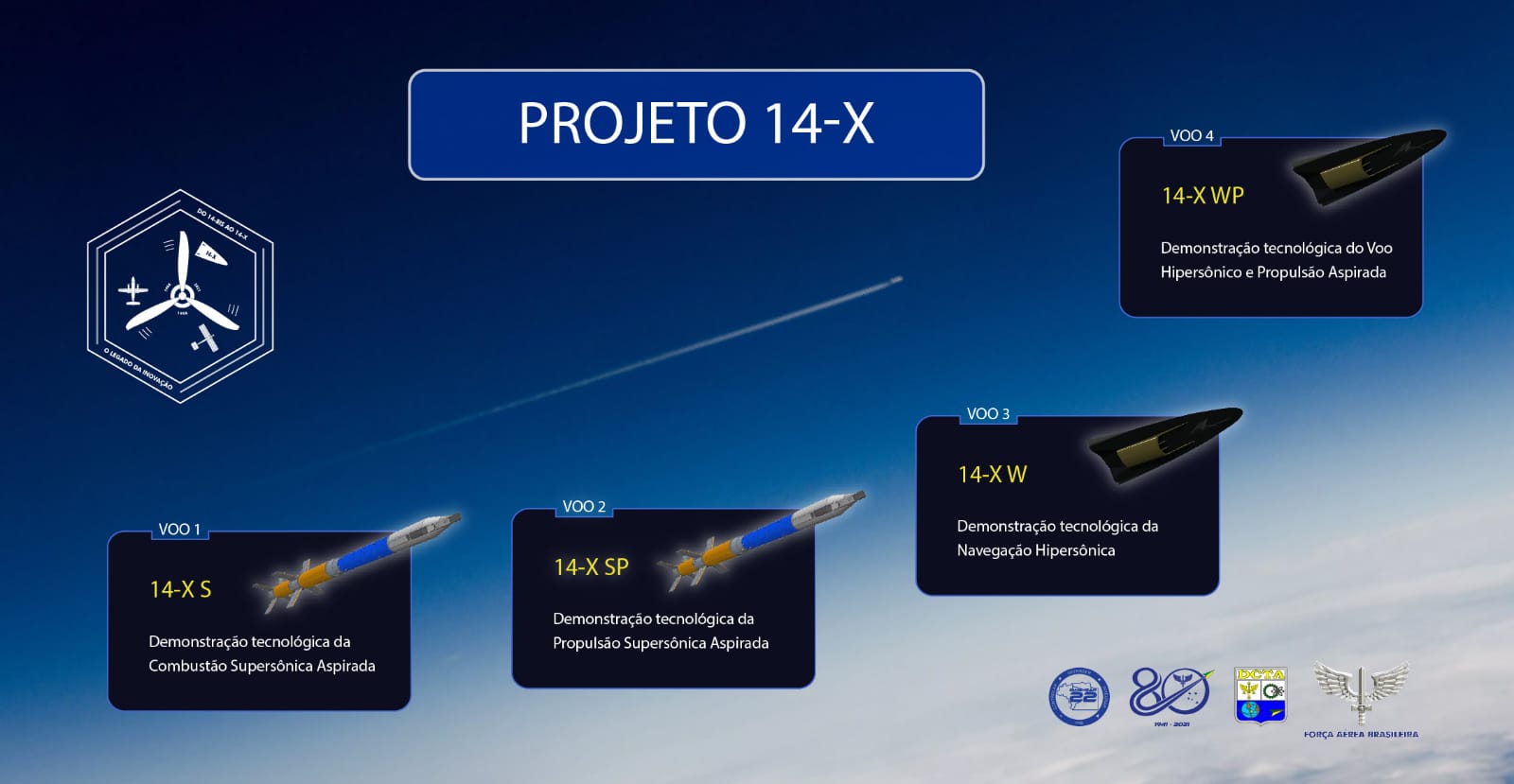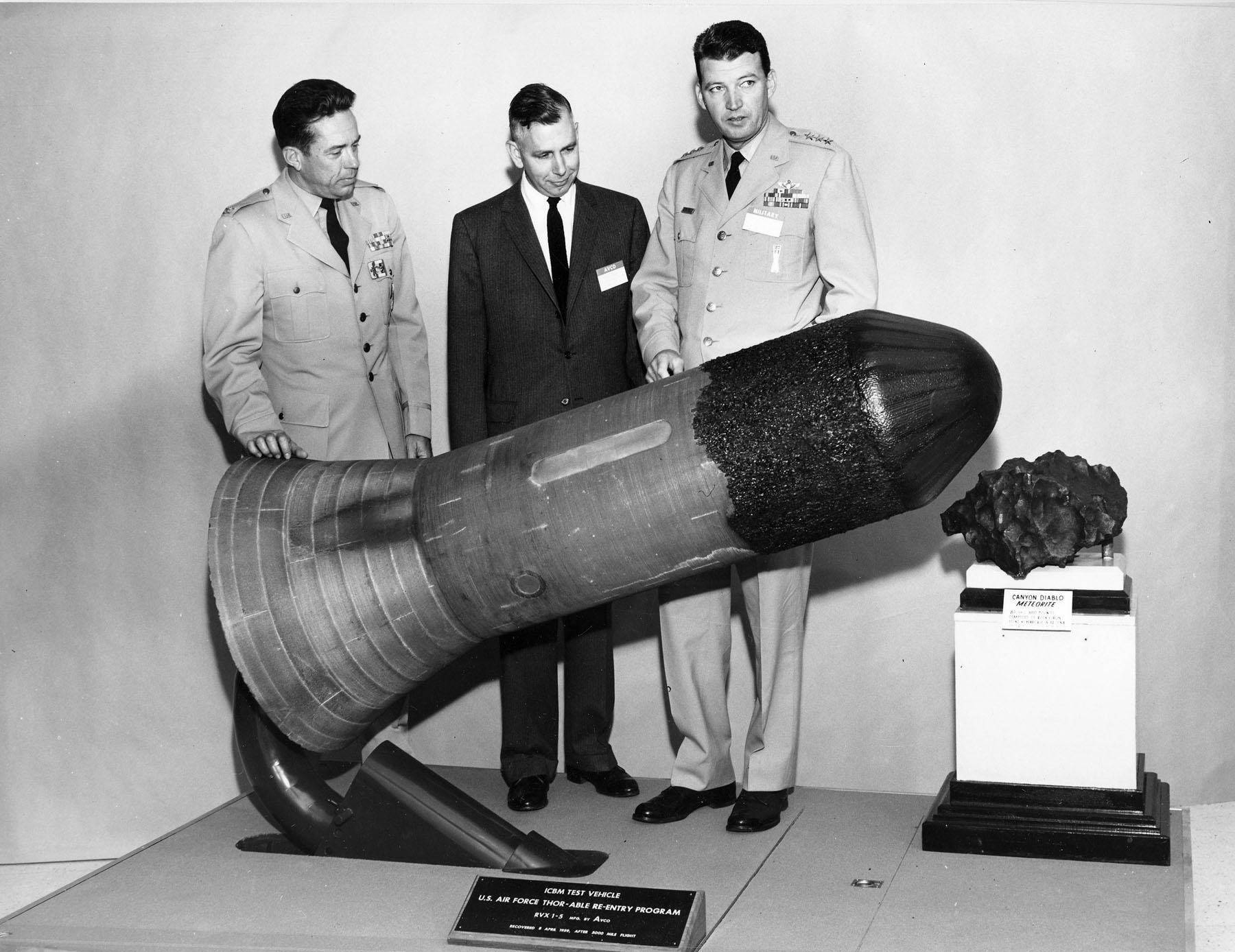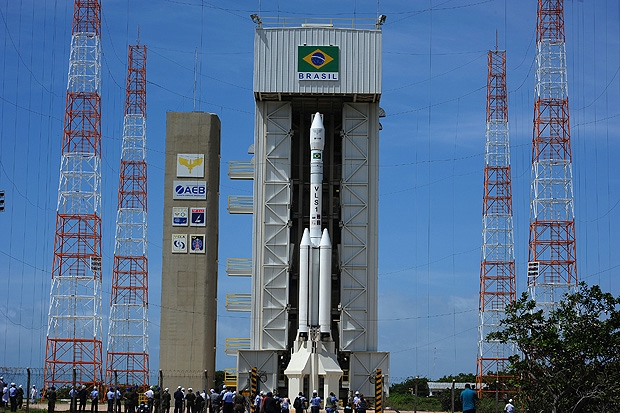|
14-X Project
The 14-X is a Brazilian scramjet engine in development by the Aerothermodynamics and Hypersonics Laboratory Henry T. Nagamatsu of the Institute of Advanced Studies (IEAv) of the Department of Aerospace Science and Technology as part of the ''PropHiper'' (Portuguese: ''Projeto de Propulsão Hipersônica 14-X''). The name is a reference to the 14-bis, of the Brazilian inventor and aviation pioneer Alberto Santos-Dumont. The Brazilian Air Force conducted the first qualification test flight of the 14-X engine on 14 December 2021 from the Alcântara Space Center. Development Brazil conducts studies in the field of aspirated hypersonics since 1990s, but an development plan was conceived only in 2007, through the ''PropHiper'' project, made official by the Air Force in 2008, when the engineer-captain of the Brazilian Air Force, Tiago Cavalcanti Rolim, started a master's degree at the Instituto Tecnológico de Aeronáutica (ITA) and was approved with a thesis on the waverider config ... [...More Info...] [...Related Items...] OR: [Wikipedia] [Google] [Baidu] |
Scramjet
A scramjet (supersonic combustion ramjet) is a variant of a ramjet airbreathing jet engine in which combustion takes place in supersonic airflow. As in ramjets, a scramjet relies on high vehicle speed to compress the incoming air forcefully before combustion (hence ''ram''jet), but whereas a ramjet decelerates the air to subsonic velocities before combustion using shock cones, a scramjet has no shock cone and slows the airflow using shockwaves produced by its ignition source in place of a shock cone. This allows the scramjet to operate efficiently at extremely high speeds. History Before 2000 The Bell X-1 attained supersonic flight in 1947 and, by the early 1960s, rapid progress toward faster aircraft suggested that operational aircraft would be flying at "hypersonic" speeds within a few years. Except for specialized rocket research vehicles like the North American X-15 and other rocket-powered spacecraft, aircraft top speeds have remained level, generally in the range ... [...More Info...] [...Related Items...] OR: [Wikipedia] [Google] [Baidu] |
Apogee
An apsis (; ) is the farthest or nearest point in the orbit of a planetary body about its primary body. For example, the apsides of the Earth are called the aphelion and perihelion. General description There are two apsides in any elliptic orbit. The name for each apsis is created from the prefixes ''ap-'', ''apo-'' (), or ''peri-'' (), each referring to the farthest and closest point to the primary body the affixing necessary suffix that describes the primary body in the orbit. In this case, the suffix for Earth is ''-gee'', so the apsides' names are ''apogee'' and ''perigee''. For the Sun, its suffix is ''-helion'', so the names are ''aphelion'' and ''perihelion''. According to Newton's laws of motion, all periodic orbits are ellipses. The barycenter of the two bodies may lie well within the bigger body—e.g., the Earth–Moon barycenter is about 75% of the way from Earth's center to its surface. If, compared to the larger mass, the smaller mass is negligible (e.g ... [...More Info...] [...Related Items...] OR: [Wikipedia] [Google] [Baidu] |
2020s Brazilian Military Aircraft
S, or s, is the nineteenth letter in the Latin alphabet, used in the modern English alphabet, the alphabets of other western European languages and others worldwide. Its name in English is ''ess'' (pronounced ), plural ''esses''. History Origin Northwest Semitic šîn represented a voiceless postalveolar fricative (as in 'ip'). It originated most likely as a pictogram of a tooth () and represented the phoneme via the acrophonic principle. Ancient Greek did not have a phoneme, so the derived Greek letter sigma () came to represent the voiceless alveolar sibilant . While the letter shape Σ continues Phoenician ''šîn'', its name ''sigma'' is taken from the letter ''samekh'', while the shape and position of ''samekh'' but name of ''šîn'' is continued in the '' xi''. Within Greek, the name of ''sigma'' was influenced by its association with the Greek word (earlier ) "to hiss". The original name of the letter "sigma" may have been ''san'', but due to the ... [...More Info...] [...Related Items...] OR: [Wikipedia] [Google] [Baidu] |
Hypersonic Aircraft
Hypersonic flight is flight through the atmosphere below altitudes of about 90 km at speeds greater than Mach 5, a speed where dissociation of air begins to become significant and high heat loads exist. Speeds of Mach 25+ have been achieved below the thermosphere as of 2020. History The first manufactured object to achieve hypersonic flight was the two-stage Bumper rocket, consisting of a WAC Corporal second stage set on top of a V-2 first stage. In February 1949, at White Sands, the rocket reached a speed of , or about Mach 6.7. The vehicle, however, burned on atmospheric re-entry, and only charred remnants were found. In April 1961, Russian Major Yuri Gagarin became the first human to travel at hypersonic speed, during the world's first piloted orbital flight. Soon after, in May 1961, Alan Shepard became the first American and second person to fly hypersonic when his capsule reentered the atmosphere at a speed above Mach 5 at the end of his suborbital flight over ... [...More Info...] [...Related Items...] OR: [Wikipedia] [Google] [Baidu] |
Scramjet Programs
Scramjet programs refers to research and testing programs for the development of supersonic combustion ramjets, known as scramjets. This list provides a short overview of national and international collaborations, and civilian and military programs. The USA, Russia, India, and China (2014), have succeeded at developing scramjet technologies. USA X-15 When the second X-15 aircraft (piloted by John B. McKay) crashed on flight 74, it was damaged but survived well enough to be rebuilt. North American Aviation rebuilt it as the X-15-A2. Among other things, one of the changes was provisions for a dummy scramjet to test if wind tunnel testing was correct. Unfortunately, on the final flight of the X-15-A2 ( flight 188), the shock waves sent out by the scramjet at Mach 6.7 caused extremely intense heating of over . This then drilled into the ventral fin and melted large holes. The plane survived but never flew again. Test data were limited due to the limited flights of the scramjet before ... [...More Info...] [...Related Items...] OR: [Wikipedia] [Google] [Baidu] |
Cruise Missile
A cruise missile is a guided missile used against terrestrial or naval targets that remains in the atmosphere and flies the major portion of its flight path at approximately constant speed. Cruise missiles are designed to deliver a large warhead over long distances with high precision. Modern cruise missiles are capable of travelling at high subsonic, supersonic, or hypersonic speeds, are self-navigating, and are able to fly on a non- ballistic, extremely low-altitude trajectory. History The idea of an "aerial torpedo" was shown in the British 1909 film '' The Airship Destroyer'' in which flying torpedoes controlled wirelessly are used to bring down airships bombing London. In 1916, the American aviator Lawrence Sperry built and patented an "aerial torpedo", the Hewitt-Sperry Automatic Airplane, a small biplane carrying a TNT charge, a Sperry autopilot and a barometric altitude control. Inspired by the experiments, the United States Army developed a similar flying bomb ... [...More Info...] [...Related Items...] OR: [Wikipedia] [Google] [Baidu] |
Brazilian Space Program
The Brazilian space program is the rocketry and space exploration programs conducted by Brazil from 1961 until the creation of the Brazilian Space Agency in 1994. It had significant capabilities in launch vehicles, launch sites, and satellite manufacturing. It was based at the National Institute for Space Research (INPE), under the Ministry of Science and Technology (MCT). The program was under complete military control, which hindered its development, as other countries (such as the United States) blocked technological development due to concerns over missile proliferation. In 1994, the space program was transferred to civilian control under the Brazilian Space Agency. History Since 1964, in an attempt to build a satellite launch vehicle ( ''Veículo Lançador de Satélite--VLS''), Brazil has developed a series of sounding (research) rockets, named Sonda I, II, III, and IV. The early Sondas were test-launched from Barreira do Inferno Launch Center, near the city of Natal ... [...More Info...] [...Related Items...] OR: [Wikipedia] [Google] [Baidu] |
Ballistic Missile
A ballistic missile is a type of missile that uses projectile motion to deliver warheads on a target. These weapons are guided only during relatively brief periods—most of the flight is unpowered. Short-range ballistic missiles stay within the Earth's atmosphere, while intercontinental ballistic missiles (ICBMs) are launched on a sub-orbital flight. These weapons are in a distinct category from cruise missiles, which are aerodynamically guided in powered flight. Unlike cruise missiles, which are restricted to the atmosphere, it is advantageous for ballistic missiles to avoid the denser parts of the atmosphere and they may travel above the atmosphere into outer space. History The earliest form of ballistic missile dates from the 13th century with its use derived from the history of rockets. In the 14th century, the Ming Chinese navy used an early form of a ballistic missile weapon called the Huolongchushui in naval battles against enemy ships.Needham, Volume 5, Part ... [...More Info...] [...Related Items...] OR: [Wikipedia] [Google] [Baidu] |
Civil Aviation
Civil aviation is one of two major categories of flying, representing all non-military and non-state aviation, both private and commercial. Most of the countries in the world are members of the International Civil Aviation Organization and work together to establish common Standards and Recommended Practices for civil aviation through that agency. Civil aviation includes three major categories: * Commercial air transport, including scheduled and non-scheduled passenger and cargo flights * Aerial work, in which an aircraft is used for specialized services such as agriculture, photography, surveying, search and rescue, etc. * General aviation (GA), including all other civil flights, private or commercial Although scheduled air transport is the larger operation in terms of passenger numbers, GA is larger in the number of flights (and flight hours, in the U.S.) In the U.S., GA carries 166 million passengers each year, more than any individual airline, though less than all the airl ... [...More Info...] [...Related Items...] OR: [Wikipedia] [Google] [Baidu] |
Intercontinental Ballistic Missiles
An intercontinental ballistic missile (ICBM) is a ballistic missile with a range greater than , primarily designed for nuclear weapons delivery (delivering one or more thermonuclear warheads). Conventional, chemical, and biological weapons can also be delivered with varying effectiveness, but have never been deployed on ICBMs. Most modern designs support multiple independently targetable reentry vehicles (MIRVs), allowing a single missile to carry several warheads, each of which can strike a different target. Russia, the United States, China, France, India, the United Kingdom, and North Korea are the only countries known to have operational ICBMs. Early ICBMs had limited precision, which made them suitable for use only against the largest targets, such as cities. They were seen as a "safe" basing option, one that would keep the deterrent force close to home where it would be difficult to attack. Attacks against military targets (especially hardened ones) still demanded t ... [...More Info...] [...Related Items...] OR: [Wikipedia] [Google] [Baidu] |
Hypersonic Glide Vehicle
Hypersonic glide vehicle (HGV) is a type of warhead for ballistic missile that can maneuver and glide at hypersonic speed. It is used on ballistic missiles to significantly change their trajectories. Conventional ballistic missiles follow a predictable ballistic trajectory and are vulnerable to interception by the latest anti-ballistic missile (ABM) systems. HGV makes them unpredictable, allowing them to evade air defenses. Hypersonic glide vehicles are currently subject of an arm race. Countermeasures Boost-glide weapons are generally designed to avoid existing missile defense systems, either by continually maneuvering or by flying at lower altitudes to reduce warning time. This generally makes such weapons easier to intercept using defensive systems intended for lower-altitude "low-tier" targets. Flying at lower speeds than short-range ballistic missile warheads makes them easier to attack. Those that approach with very low terminal attack profiles are even subject to attack ... [...More Info...] [...Related Items...] OR: [Wikipedia] [Google] [Baidu] |
14-XS
14-XS was an ''Operação Cruzeiro'' mission conducted at the Alcantara Launch Center on December 14, 2021. Mission Conducted by the Brazilian Air Force, the flight was a test to demonstrate the scramjet technology. The device was launched by a Hypersonic Accelerator Vehicle (based on the VSB-30 rocket) and accelerated to Mach 6 to an altitude of 30 kilometers, from where it continued until it reached a suborbital apogee at an altitude of 160 kilometers and 200 kilometers down range from the launch site, impacting at the Atlantic Ocean. The model tested combustion in a hypersonic environment and Mach 6 speed was reached at 50 km. Both the Alcântara Launch Center and the Barreira do Inferno Launch Center acted as tracking stations. The vehicle was the first with a scramjet engine built in Brazil and reached up to 5,000 hp. The vehicle was built by Orbital Engenharia. Both the rocket and the 14-X were built in São José dos Campos. The engine has been under development since 20 ... [...More Info...] [...Related Items...] OR: [Wikipedia] [Google] [Baidu] |

.png)






